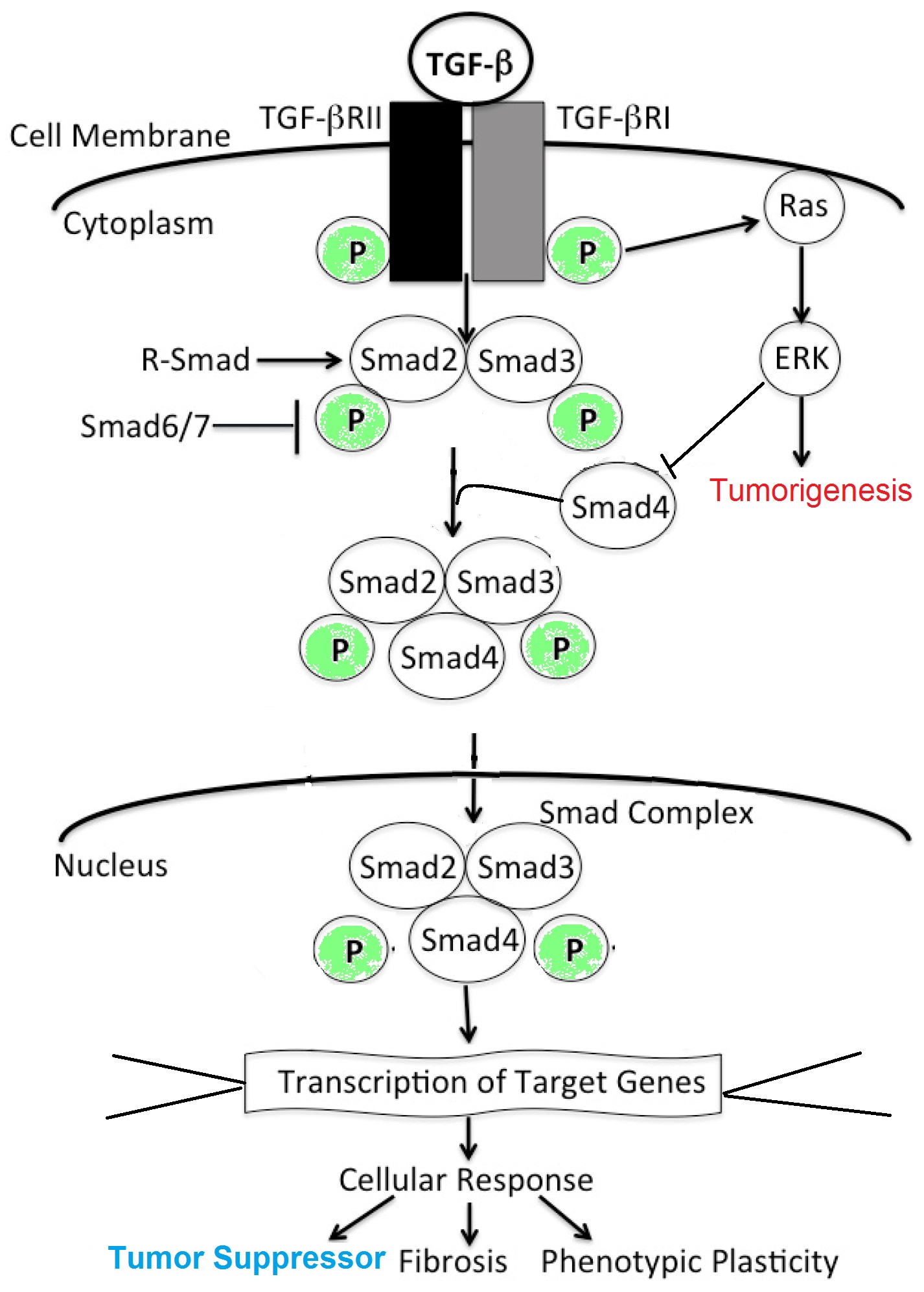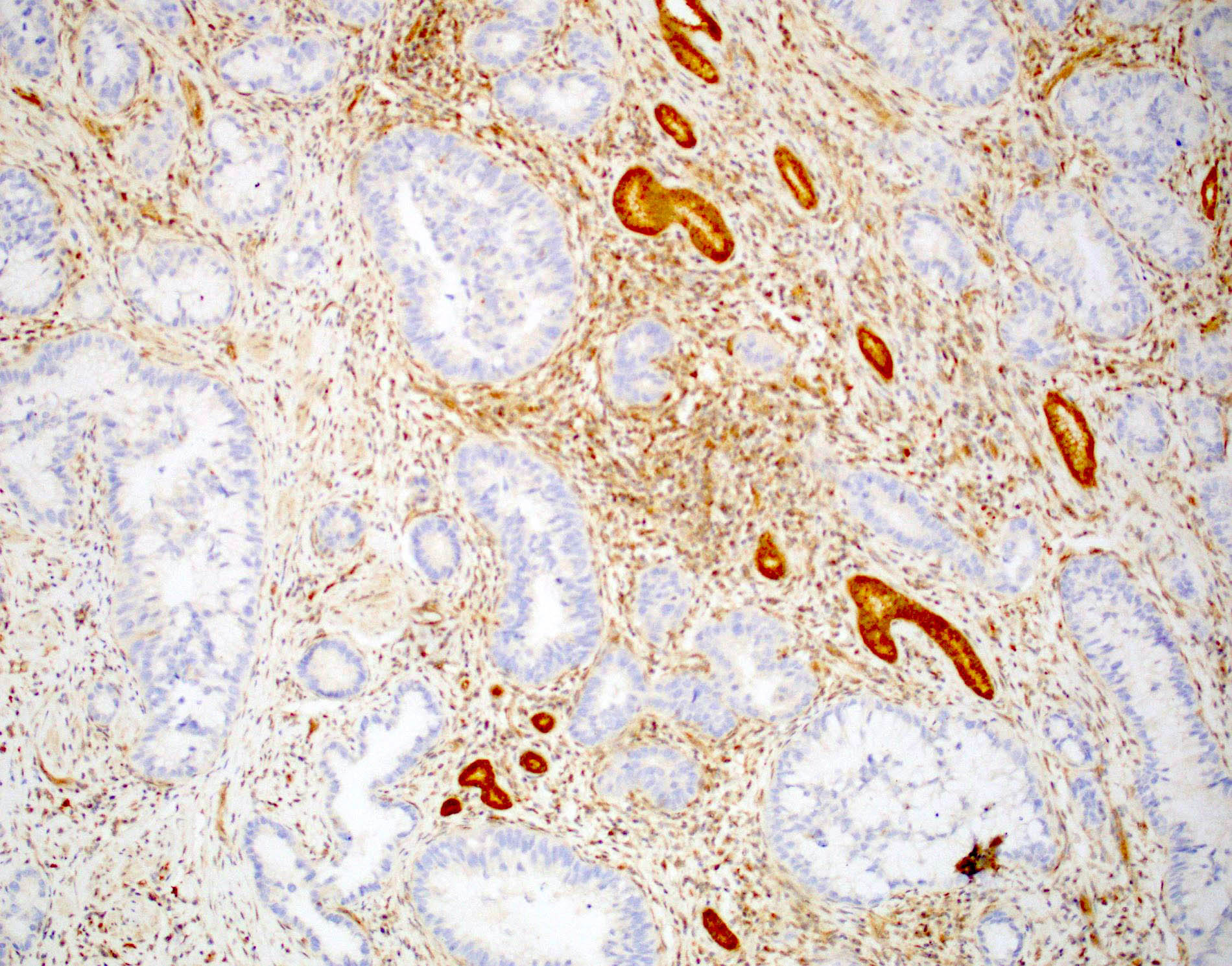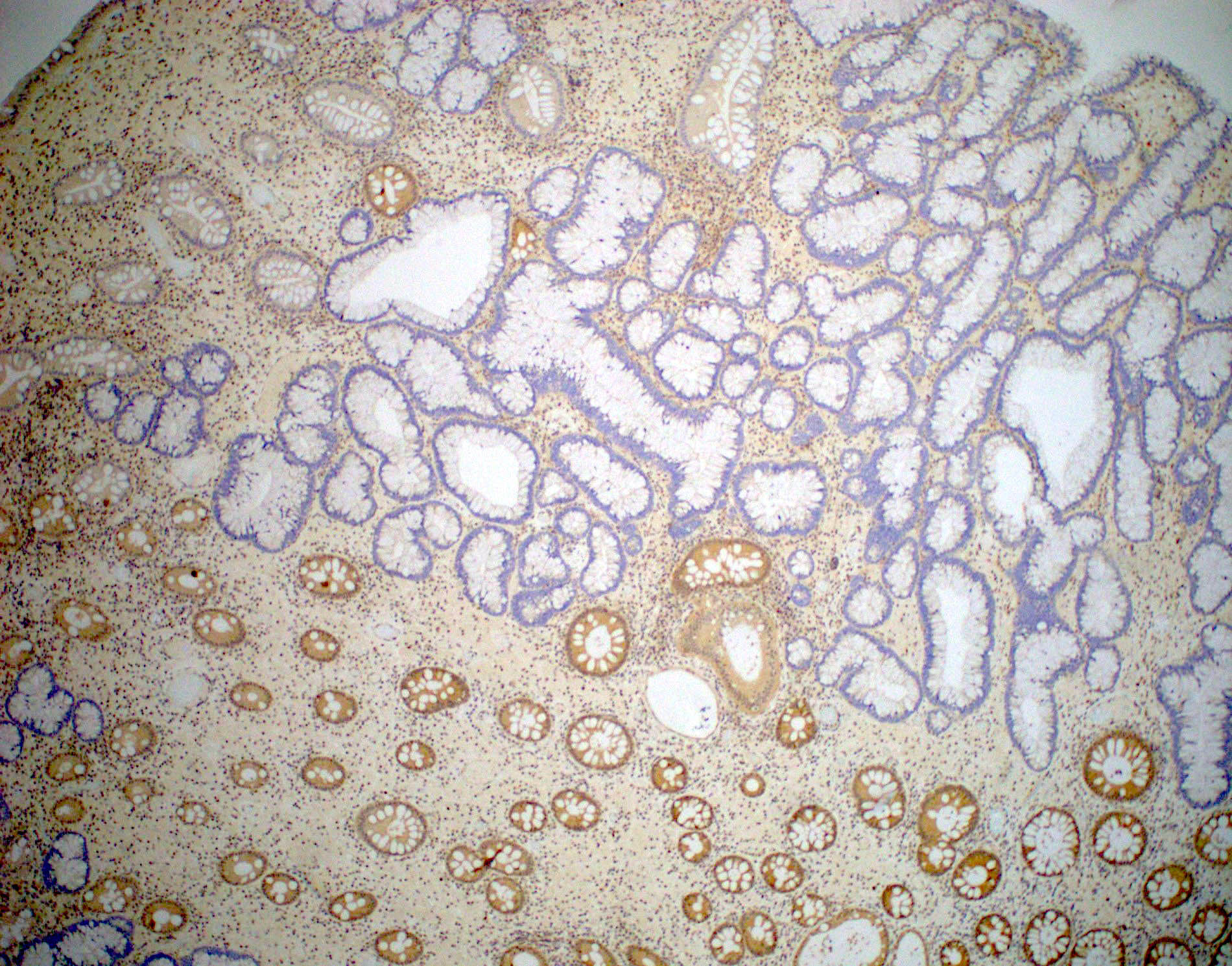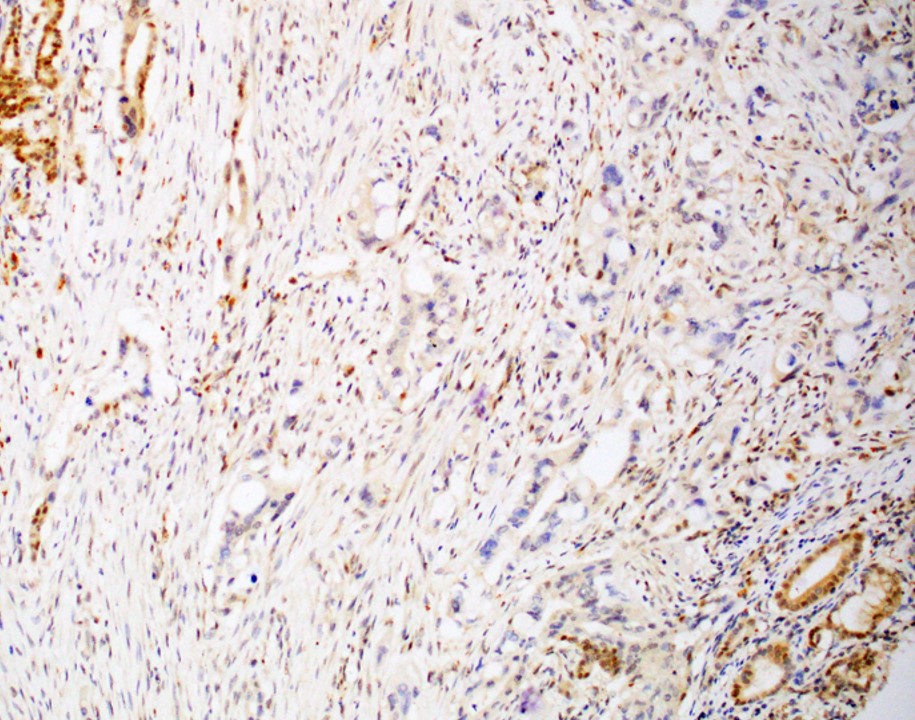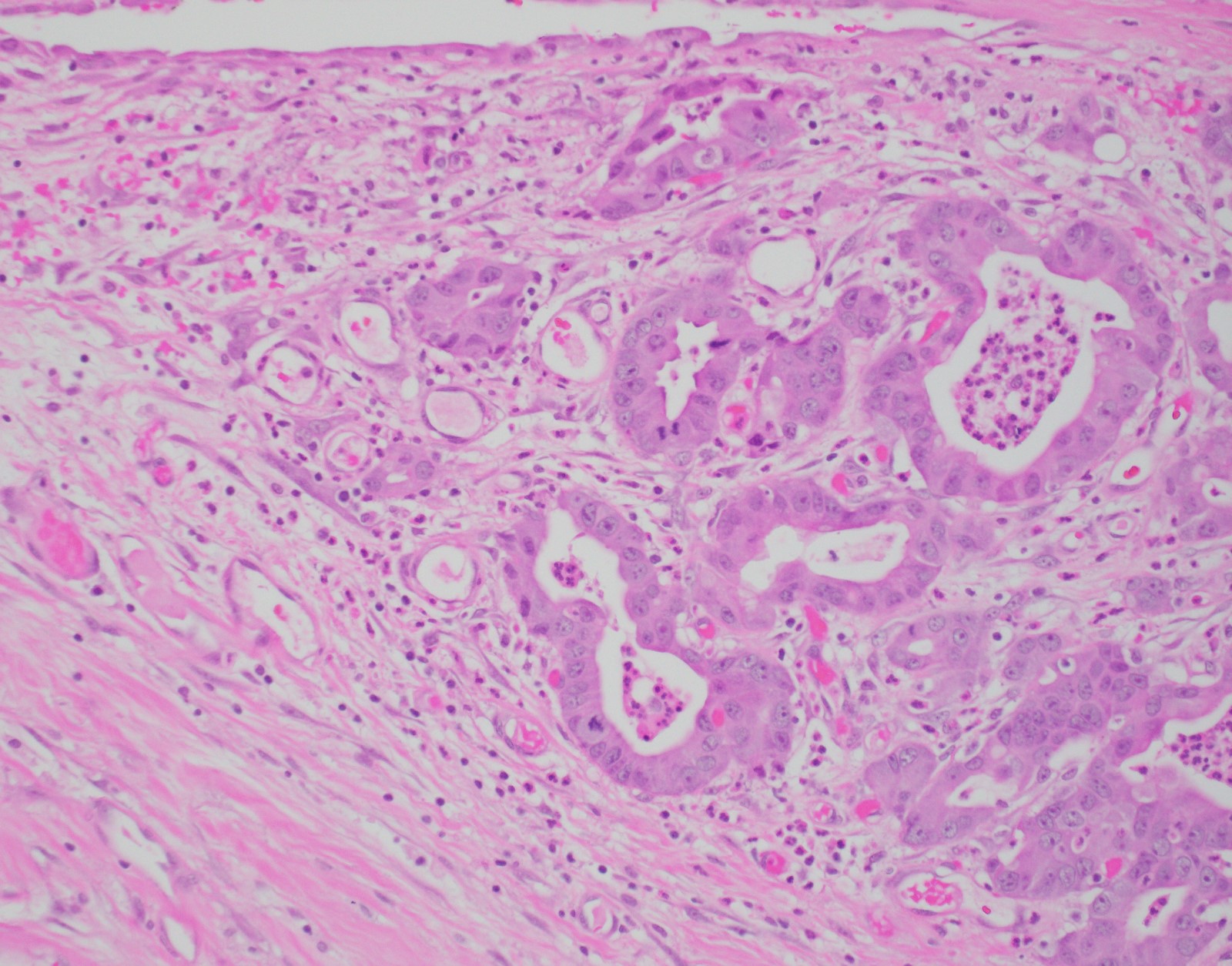Table of Contents
Definition / general | Essential features | Terminology | Pathophysiology | Diagrams / tables | Clinical features | Interpretation | Uses by pathologists | Prognostic factors | Microscopic (histologic) description | Microscopic (histologic) images | Positive staining - normal | Positive staining - disease | Negative staining | Sample pathology report | Practice question #1 | Practice answer #1Cite this page: Liao X, Zhang D. SMAD4 / DPC4. PathologyOutlines.com website. https://www.pathologyoutlines.com/topic/stainsdpc4.html. Accessed August 19th, 2025.
Definition / general
- One of the SMAD family of transcription factor proteins, encoded by SMAD4 gene located on chromosome 18q21.1 (Cancer Res 1998;58:3700)
- 552 amino acid polypeptide with a molecular weight of 60.439 Da; has 2 functional domains known as MH1 and MH2
- Tumor suppressor, which inhibits the TGFβ signaling pathway suppressing epithelial cell growth (Cell 2009;136:13)
Essential features
- SMAD4 tumor suppressor gene is mutated in ~ 55% of pancreatic ductal adenocarcinoma, 25% of extrahepatic cholangiocarcinoma, 34% of ampullary carcinoma and 10 - 20% of colorectal carcinomas, including appendix (Cancer Res 2000;60:2002, PLoS One 2017;9:e115383, Mod Pathol 2003;16:272, Oncogene 1999;18:3098)
- Majority of SMAD4 gene mutations in human cancer are missense, nonsense and frameshift mutations at the mad homology 2 region (MH2), which interfere with the homo-oligomer formation of SMAD4 protein and the hetero-oligomer formation between SMAD4 and SMAD2 proteins, resulting in disruption of TGFβ signaling (Mol Cell 2004;15:813)
- Immunohistochemical staining for SMAD4 showing loss of nuclear stain is practically a surrogate for SMAD4 genetic mutation (Am J Pathol 2000;156:37)
Terminology
- SMAD family member 4 or DPC4 (deleted in pancreatic cancer 4)
- Mammalian SMAD4 is a homolog of the Drosophila protein, mothers against decapentaplegic, named Medea
Pathophysiology
- SMAD4 interacts with receptor-regulated SMADs (R-SMADs), such as SMAD2, SMAD3, SMAD1, SMAD5 and SMAD8 (also called SMAD9) to form heterotrimeric complexes (Cold Spring Harb Perspect Biol 2016;8:a022087)
- Once in the nucleus, the complex of SMAD4 and 2 R-SMADs binds to DNA and regulates the expression of different genes depending on the cellular context
Diagrams / tables
Clinical features
- SMAD4 is also found mutated in the autosomal dominant disease juvenile polyposis syndrome, which is characterized by hamartomatous polyps in the gastrointestinal tract (Science 1998;280:1086)
- Mutations in SMAD4 (mostly substitutions) can cause Myhre syndrome, a rare inherited disorder characterized by mental disabilities, short stature, unusual facial features and various bone abnormalities (Am J Hum Genet 2012;90:161)
Interpretation
- Nuclear stain if SMAD4 protein intact
- Loss of nuclear stain or weak cytoplasmic stain indicate SMAD4 loss and are a surrogate for SMAD4 gene mutation / deletion (Am J Clin Pathol 2001;116:831)
Uses by pathologists
- Loss of SMAD4 nuclear expression combining with other immunomarkers can be used to determine tumor origin in cases of metastasis of unknown primary
- In pancreatic tissue, loss of SMAD4 nuclear expression can distinguish malignancy (in situ or invasive) versus benign process; particularly helpful in biopsies (Am J Clin Pathol 2001;116:831)
- In mucinous carcinoma peritonei associated with a mucinous appendiceal neoplasm, SMAD4 loss can indicate high grade transformation (Am J Surg Pathol 2014;38:583)
- In patients with increased juvenile colon polyps, loss of SMAD4 in those polyps is helpful for making the diagnosis of juvenile polyposis syndrome
Prognostic factors
- In colorectal carcinoma, SMAD4 loss / SMAD4 mutation is associated with higher stage, mucinous differentiation, background Crohn's disease and concurrent RAS mutations (PLoS One 2019;14:e0212142)
Microscopic (histologic) description
- Loss of nuclear expression of SMAD4 in tumor cells in contrast to retained nuclear staining in surrounding stromal cells, lymphocytes or benign epithelial cells
Microscopic (histologic) images
Positive staining - normal
- Nuclear stain in nearly all normal tissue from all organs
Positive staining - disease
- Nuclear stain indicates no SMAD4 protein loss or SMAD4 gene mutation
Negative staining
- Loss of nuclear stain in pancreatobiliary and colorectal carcinomas
Sample pathology report
- Pancreas, mass, biopsy:
- Well differentiated adenocarcinoma.
- SMAD4 immunohistochemistry shows loss of nuclear expression in tumor cells, confirming the diagnosis.
Practice question #1
A patient presents with hernia sac mass, resection of which showed moderately differentiated adenocarcinoma of unknown primary. The patient underwent abdominal CT examination, which showed a possible pancreatic mass. Which immunohistochemical stain result would be most helpful in determining the tumor cells are of pancreatic origin?
- CDX2 negative
- CDX2 positive
- Loss of SMAD4 nuclear stain
- Retained nuclear SMAD4 stain
Practice answer #1



